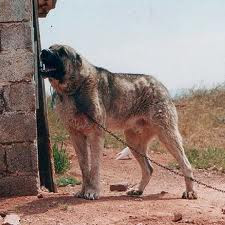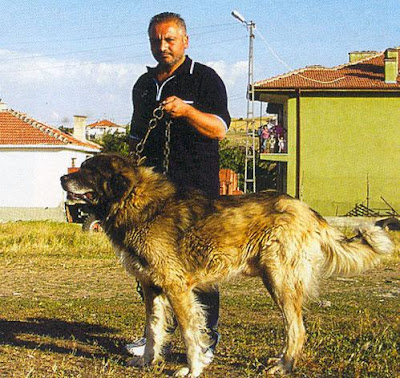This Kars
Dog breed is named after the Kars province, where it is most common. Considered by many to be just another variant of the Caucasian Ovcharka, the Kars Dog is believed by most Turks to be the ancestor of the European mountain breeds. It should be noted that Kars was the capital of Armenia in the 10th century A.D. and this breed is closely related to the ancient Gampr and the Sarplaninac, as well as to certain strains of Sylvans, Azerbaijan Shepherds, Tushetian Nagazis and Circassian Sheepdogs, but also old Persian Sheepdogs, Turkish Mastiffs, Yoruk Sheepdogs and Kangals. This rugged Molosser is still being bred today by shepherds for its working abilities and not visual standards, just like it has been for centuries, resulting in a great variety of sizes, colours and coat types. However, the most common and popular Kars
Dog type is almost identical to the Nagazi variant of the Caucasian Shepherd Dog. Turkish dogs are said to be very healthy and there are some reports of European C.O. breeders buying Kars puppies to improve their bloodlines.
Heavy and intimidating, the Kars
Dog is extremely aggressive and territorial, best suited for rural environment, although it it can make an agreeable companion for experienced owners if provided with proper socialization and training. Devoted to its master and very protective of its flock, this breed is highly valued by the shepherds of Eastern Turkey, where it's still being used for the work it was bred to do, as well as an occasional fighting dog. This is a strong, well-boned and powerful Molosser, with a large head, wide chest and broad shoulders. The ears are usually cropped, but many dogs can be seen unaltered. Even though there are a few variants and coat lengths, the most valued dogs are the tall, long coated bear-type dogs, coming in various colourings, both solid and piebald, with the wolf-grey specimens being preferred. The average height is around 28 inches, although smaller, as well as much taller dogs exist.
Kars
Dog are bred in the northeast part of Turkey, especially in the Kars region. This region of Turkey neighbors other Caucasian countries. Kars dogs are characteristically similar to the Caucasian Ovcharka, which is bred in Georgia, Armenia, Azerbaijan and Iran. The Caucasian Ovcharka, which is also known as the Caucasian mountain dog, is a guard dog from the Caucasus mountains area. The Caucasian Ovcharka has been recognized and classified by the Federation Cynologique Internationale and the United Kennel Club. Kangal, Akbash and Kars dogs are specific Turkish livestock-guarding breeds gathered under the general rubric of Turkish shepherd dogs. The characteristic features of Kangal and Akbash dogs are well known all over the world. However, Kars dogs were only reported for the first time by Nelson in 1996.
The mean body weight and mean height at withers of Kangal dogs have been reported to be 40.5-41.0 kg and 66.2-71.1 cm for males and 32.4-35.8 kg and 60.8- 66.9 cm for females, respectively. For the Caucasian Ovcharka, the mean withers height, the index of format and the index of bone are reported to be 65-85 cm, 102-108 and 21-22 for males and 62-75 cm, 102-108 and 20-22 for females, respectively. Kars dogs are strongly muscled and well boned. The head is large and mastiff and often has a dark fascial mask. Coat color is dark or light agouti gray, and it is lighter (light gray or yellowish) towards the tail and legs. Coat length can be long, medium or short. Ears are triangular and hang tight to the head. Eyes are brown or dark brown, medium-sized and oval This study was carried out to determine the body weight and some body measurements of Kars dogs.
In the present study, 33 adult (2+ years old) male and 27 female Kars dogs were used. The dogs were raised by different breeders in several different villages of the Kars region. The dogs were weighed and their body length, head length, head circumference, distance between ears, wrist circumference, height at withers, chest circumference, chest depth, chest width, height at rump and rump width were measured using methods reported by …zcan and AltÝnel and Tepeli and etin. Due to the common practice of cutting dogsÕ ears in the region, the lengths of the ear-flaps were not included in the study. Indexes of format and of bone were calculated by the formulas given below. Index of format = body length x 100/height at withers Index of bone = wrist circumference x 100/height at withers Statistical Analysis.
Aim of this study was to serologically investigate the CAV infection in Kars Dogs from Kars region of Turkey. In the present study, 57 adult male and 37 female (above 1 year old) Kars Dogs were used. For this purpose, samples were collected from Kars Dogs (94) in Kars region of Turkey. None of these dogs are vaccinated against CAV types before. Definite health records of the sampled dogs are not obtained, so any clinical symptoms is not known. In this study, the seropositivity of CAV was found as 65.95 % (62/94). The proportions of seropositive male and female Kars Dogs were 63.15% (36/57) and 70.27% (26/37), respectively. The infection was studied for the first time in Kars Dogs of Turkey.
The two diseases caused by canine adenoviruses (CAV) are the most important adenovirus infections of animals worldwide. Infections canine hepatitis, caused by CAV type 1, dogs younger than one year of age are the most often affected also an important pathogen of foxes, wolves, coyotes, skunks and bears. Other carnivores may be latent carrier of the virus. The disease occurs world widely, but is uncommon where vaccination is practiced. In fact, CAV type 1 was recognized as a specific viral disease of dogs by Rubarth in 1947. In dogs, the virus may also cause respiratory or ocular disease, encephalopathy, chronic hepatitis and interstitial nephritis. CAV type 2 causes respiratory disease with tonsillitis, pharyngitis, tracheitis, bronchitis and bronchopneumonia. Although there was antigenic relatedness and cross-protective immunity between two types, restriction endonuclease analysis shown that they are genetically different viruses. The main transmission routes of the diseases are oro-nasal exposure to contaminated saliva, urine and feces. Recovered dogs may shed virus in their urine for up to 6 months.
Clinical period of CAV type 1 lasts up to one week in normal conditions, rarely some Kars dog can develop chronic hepatitis, this situation is generally seen in the presence of concurrent infections. The incubation period is 4 to 7 days. Clinical signs include depression, fever, vomiting, diarrhea, and nasal and ocular discharges, rhinitis, ataxia, anorexia, tonsillitis, abdominal pain, blood in feces, acute/chronic hepatitis and interstitial nephritis. Encephalitis is not an often event but deaths can occur in very short time with lethargy, ataxia, blindness and vomiting findings. Because of a tendency to bleed, hematomas may be seen in the mouth. Recovered dogs may develop a transient corneal opacity ("blue eye") as a result of local immune complex deposition. Recovery from infectious canine hepatitis (ICH) results in lifelong immunity.
CAV type 2 causes an infection of the respiratory tract that is usually unapparent or mild. It has been implicated as one of the causes, not the most important, of the common widespread disease kennel cough or infectious canine laryngotracheitis, which is associated with kennels and animal hospitals. The etiology of kennel cough is complex. Canine parainfluenza 2 and Bordetella bronchiseptica seem to also play major roles. CAV resembles several other viral infections of dogs, so that a definitive diagnosis requires laboratory confirmation. Several methods such as enzyme linked immunosorbent assay (ELISA), polymerase chain reaction (PCR), virus isolation, electron microscopy, haemagglutination inhibition (HAI), serum neutralization and complement-fixation can be used to diagnose the CAV infection. Indirect ELISA is also one of the most sensitive, reliable and fast method. Aim of the present study is to investigate the CAV infection serologically in Kars Dogs in Kars region of Turkey.

















0 comments:
Post a Comment